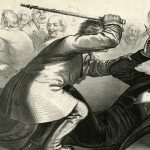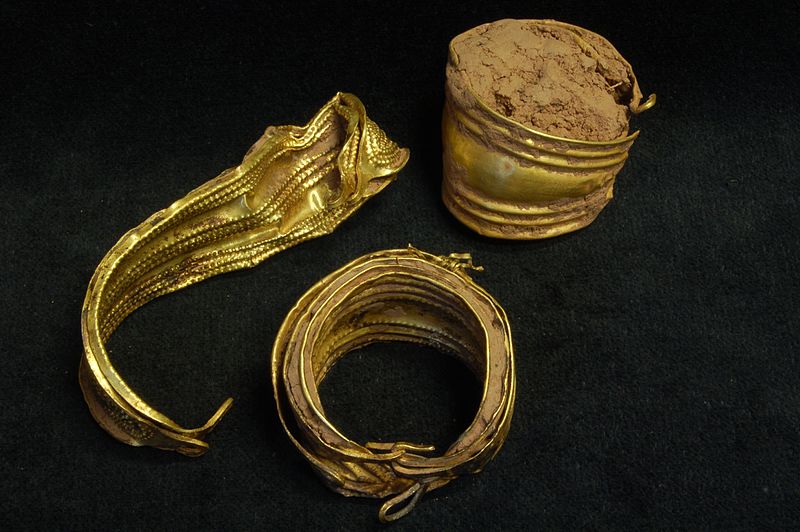 Mysteries
Mysteries  Mysteries
Mysteries  History
History 10 Surprising Stories About the Texas Rangers
 Humans
Humans 10 Philosophers Who Were Driven Mad by Their Own Theories
 Miscellaneous
Miscellaneous 10 Video-Game-Worthy Weapons and Armors from History
 Weird Stuff
Weird Stuff 10 Psychics Who Accurately Predicted Wartime Events
 The Arts
The Arts 10 Pieces of Art Inspired by a Broken Heart
 Health
Health 10 Science Fiction-Sounding New Medical Treatments
 History
History 10 Surprising Facts About the Father of Submarine Warfare
 Space
Space Ten Astonishing New Insights into Alien Worlds
 Weird Stuff
Weird Stuff 10 Bizarre Summer Solstice Rituals Still Practiced Today
 Mysteries
Mysteries Top 10 Haunting Facts About the Ghost Ship MV Alta
 History
History 10 Surprising Stories About the Texas Rangers
 Humans
Humans 10 Philosophers Who Were Driven Mad by Their Own Theories
Who's Behind Listverse?

Jamie Frater
Head Editor
Jamie founded Listverse due to an insatiable desire to share fascinating, obscure, and bizarre facts. He has been a guest speaker on numerous national radio and television stations and is a five time published author.
More About Us Miscellaneous
Miscellaneous 10 Video-Game-Worthy Weapons and Armors from History
 Weird Stuff
Weird Stuff 10 Psychics Who Accurately Predicted Wartime Events
 The Arts
The Arts 10 Pieces of Art Inspired by a Broken Heart
 Health
Health 10 Science Fiction-Sounding New Medical Treatments
 History
History 10 Surprising Facts About the Father of Submarine Warfare
 Space
Space Ten Astonishing New Insights into Alien Worlds
 Weird Stuff
Weird Stuff 10 Bizarre Summer Solstice Rituals Still Practiced Today
Ten Actually False “Facts” from American History
As the years pass, history has a tendency to take on a life of its own. This leads to the formation of popular misunderstandings in the minds of the public. Many of those mistaken thoughts about “facts” and what “supposedly” happened center on key figures and events. This myth-making is true from early American history and even in modern times.
In today’s world, every word a politician utters in public is recorded and easily accessible by those seeking the truth. However, this was not the case in the early days of the United States. It was much more difficult to write things down and keep records of the time. So, that often led to instances of incorrect accounts of events in historical texts. Time, too, proves it has a tendency to alter stories and increase legends. Some things that were minor occurrences in their era become major (phony) events after re-tellings decades and centuries later. And that’s why we’re here today!
In this list, you’ll learn ten “facts” about American history that many believe to be true but actually occurred very differently than how they are remembered.
Related: Top 10 Brutal Realities Of The American Reconstruction
10 Betsy Ross Didn’t Make the Stars and Stripes
The story of Betsy Ross creating the inaugural United States flag has long been a part of American education. Supposedly, George Washington approached Ross and requested she design the flag. She was a creative thinker who allegedly incorporated her own ideas in the design, such as the five-pointed stars arranged in a circle. However, there is little evidence to support this narrative.
And this all goes back to the testimony of Ross’s grandson, William Canby. He first shared the tale of Betsy supposedly designing the flag in 1870. That was nearly a full century after the supposed event! Nobody before that had ever documented Ross’s alleged involvement in the flag design.
Thus, historians now believe it is most likely that Canby spread the story simply out of a desire for some family pride. In reality, it is more likely that the creation of the first American flag was a collaborative effort by many. If not, it was potentially the work of someone else entirely.
Francis Hopkinson, a signer of the Declaration of Independence, is pointed out by many historians as the likely actual designer of the stars and stripes. Thus, even despite its wide dissemination, the Betsy Ross flag story is likely just a family legend that has taken on a life of its own.[1]
9 The Civil War Didn’t End at Appomattox
It is a well-known fact that the American Civil War ended when General Robert E. Lee surrendered to General Ulysses S. Grant at Appomattox. The surrender followed the memorable and significant Battle of Appomattox Court House in Virginia on April 9, 1865. Right? Well, not quite. As it turned out, Lee’s surrender at Appomattox in early April was not the end of the war. There were actually at least a half-dozen battles that took place after this event!
Most notably, one of them was the Battle of Palmito Ranch. It took place near Brownsville, Texas, on May 12-13, 1865. It wasn’t like the combatants didn’t know about the surrender, either. Both sides were well aware of Lee’s Appomattox surrender five weeks earlier. They had even declared a ceasefire for a time. But the Union forces attempted to capture Brownsville in early May, and the two-day battle ensued.
In the end, the Confederacy emerged victorious in this final land battle of the war. It didn’t matter for the final outcome, of course. Nationally, the Union went back to the momentous task of rebuilding the country. But at least it gave the South a (very small) victory in the aftermath of the national defeat.[2]
8 The Emancipation Proclamation Didn’t Emancipate
As the President of the United States, Abraham Lincoln issued the Emancipation Proclamation on January 1, 1863. And yet, contrary to popular belief, the proclamation did not free all slaves in the country. It also did not put an end to slavery.
Rather, it only granted freedom to slaves in the Confederate states. Of course, those southern states were in the midst of rebellion against the Union already. Therefore, the proclamation mattered little to them. Planters and landowners there weren’t going to free their slaves anyway.
As for the northern states of Delaware, Kentucky, Maryland, and Missouri, which remained loyal to the Union and still held slaves, they were not affected by the proclamation. In reality, the Emancipation Proclamation was more of a symbol of the Union’s intention to end slavery if it won the Civil War.
As you’ll no doubt recall, the Union did end up winning the war. With it, their Emancipation Proclamation promise was eventually fulfilled with the ratification of the 13th Amendment to the Constitution. That amendment officially abolished slavery across the entire country—except for those convicted of a crime.[3]
7 The Confederate Flag Wasn’t the Confederate Flag
One of the most widely believed historical misconceptions is that the flag of the Confederate States of America is the well-known and highly controversial blue diagonal cross with a red background. That flag is all over the South today as a supposed symbol of the historic Confederacy.
However, this flag was never actually the official symbol of the Confederacy. It is actually one of the Confederate battle flags only—and not a political one that meant anything from a statesman’s perspective.
In reality, it was very similar to the banner used in battles by the Army of Northern Virginia, led by General Robert E. Lee. The official flag of the Confederacy was different, though. In fact, it actually changed three times during the American Civil War.
However, none of the changes ever brought it to become the one that is commonly associated with it today. It got close, though: At one point, the basic design of a blue cross on a red background was eventually partially incorporated into the official flag. However, it was always only added as a very small part of it was placed in the top corner of the redesign.[4]
6 The Liberty Bell Didn’t Crack on July 4, 1776
There are several common misconceptions about the Liberty Bell. For one, it was not called the Liberty Bell during the time of the American Revolution. In fact, it was known as the State House Bell and was housed in the Pennsylvania State House.
In fact, it wasn’t until several decades into the 1800s that it became known as the Liberty Bell. That name came about after its adoption by abolitionists. And it was obviously very long after America had gained its independence from England!
Another myth is that the bell was rung with great enthusiasm by patriots on July 4, 1776, causing it to crack. However, this is not true. The bell had actually been cracking for decades, starting in 1752. By that time, it already required frequent repairs while in the State House. Thus, it was unlikely it would have even been rung in 1776, as it was too sensitive to be used in that manner and had been for more than two decades.
As for the crack that is visible today on the bell in Philadelphia, it likely occurred in the 1840s. So, really, nothing about the Liberty Bell is really as it seems. Despite this, it remains a significant symbol for the United States to this day.[5]
5 Washington, D.C., Wasn’t Always America’s Capital
We all should know that Washington, D.C., is the capital of the United States, of course. But it isn’t the only city to hold that esteemed role. In fact, it is actually the ninth capital to hold this title. Yes, really! There were technically eight other capitals in place across the country at various times before Washington, D.C., took hold, and the honorific stuck.
Many Americans may not be aware that the first capital of the nation was Philadelphia. That’s where the Continental Congress met in 1774 and the same city in which they later signed the Declaration of Independence. So, that’s one down—eight to go.
During the Revolutionary War, the capital moved around frequently to evade the aggressive British army. At various times during the battle, it moved to various places up and down the east coast, like Baltimore and Lancaster, Pennsylvania. Other cities like York, Pennsylvania, and Princeton, New Jersey, also took on capital duties for brief revolutionary periods.
George Washington was even inaugurated as the first president in New York City and not Washington, D.C. That makes Federal Hall in the Big Apple the first capital location under the U.S. Constitution, as it was there from 1789 to 1790. After this, Philadelphia took on the role again, as did other locations. Finally, the District of Columbia was completed and officially became the capital.[6]
4 The American Mainland Wasn’t Spared in World War II
World War II did actually reach American shores, even if people today don’t realize just how close the Japanese came. Of course, Alaska and Hawaii saw wartime incursions—most notably at Pearl Harbor, which drew in American involvement in the war on December 7, 1941.
However, neither territory was a state at the time. Plus, neither one is technically part of the American mainland. So they don’t qualify here. What we’re talking about is Japanese military involvement directed at the contiguous 48 states—and that actually happened several times!
In February 1942, a Japanese submarine came up to the surface off the shore of southern California and fired on the Ellwood Oil Field near Santa Barbara. Thankfully, the missile only caused minor damage. A few months later, in June 1942, another Japanese submarine fired upon Fort Stevens in Oregon, further north up the Pacific Coast.
In September of that same year, the same submarine even sent up a floatplane high above the cloud cover in that same area. The plane flew deep inland and dropped incendiary bombs near Brookings, Oregon. The pilot was hoping to start a forest fire but, thankfully, was not successful. In fact, Americans are lucky that none of these attacks were catastrophic. Still, even though these attacks did not cause significant damage, they did occur and should not be forgotten.[7]
3 Japanese-Americans Weren’t the Only Ones Sent to Internment Camps
During World War II, President Franklin Roosevelt made the controversial decision to imprison roughly 110,000 Japanese-Americans in internment camps through Executive Order 9066. This action was prompted by the government’s fear of espionage within the Japanese-American community following the bombing of Pearl Harbor in 1941.
As a result, the civil rights of thousands of people were violated. They were forcibly relocated to camps located primarily in the western United States. It wasn’t until 1988, when President Reagan signed the Civil Liberties Act that the government formally apologized for this dark chapter in American history.
Despite widespread belief, Japanese-Americans were not the only individuals detained in internment camps in World War II. More than 11,000 German-American residents of the U.S. were sent to camps, too. Also, a number of Japanese-Latin Americans were sent to camps. In addition, the South American nation of Peru had a large Japanese minority.
Many Japanese-Peruvians were descendants of immigrants who arrived in the country during the 19th century in search of work. By the time the war began, the Japanese-Peruvian population had grown to nearly 25,000 people. Some in Peru, fueled by resentment toward the Japanese there, used this as an excuse to deport Japanese-Peruvian citizens to the United States and its internment camps. Thus, this shameful period of history extended far beyond America’s camps.[8]
2 Ronald Reagan Didn’t Free the Iran Hostages
There’s a widespread belief that President Ronald Reagan was responsible for bringing an end to the Iran hostage crisis. However, this narrative is flawed. It may have (technically) happened under his watch, but it wasn’t brought about by him. Rather, it came about merely because of the departure of the hated guy before him.
As such, some claim that Iran respected Reagan more than his predecessor, President Jimmy Carter. Therefore, the story goes, the Iranians released their infamous hostages after Reagan’s inauguration in early 1981. It may be true that Iran wanted to deal with Reagan more than Carter. But Reagan had no involvement in the negotiations to secure the release of the hostages.
In reality, the Carter Administration had already been negotiating with Iran since September 1980. Iran’s decision to release the hostages was not a result of Reagan’s perceived strength since he wasn’t in office at the time. Instead, Iran waited until Reagan got into office and then immediately released the hostages themselves—in a very blatant attempt to discredit Carter as he left the White House at the end of his term.
In spite of all this, Reagan received a significant amount of credit for the resolution of the crisis, even though he had little to do with it. But his regime ran with the reputation it gave him as an American leader projecting supposed strength, and they never looked back.[9]
1 Confederate Support Wasn’t Unanimous in the South
Let’s revisit the Civil War one more time, shall we? Of course, a number of Southern states decided to leave the United States and create the Confederate States of America at the outset of the Civil War in 1861. However, not everyone in these states was in favor of this decision. The state of West Virginia still exists today because its citizens chose to break away from Virginia rather than join the Confederacy.
Similarly, Tennessee almost experienced internal divisions of its own that would have been catastrophic. On June 8, 1861, a significant majority of voters in eastern Tennessee voted against seceding from the United States. After this vote, some counties in eastern Tennessee requested permission from the state government in Nashville to remain part of the United States. That request was denied by the local government in Nashville, creating significant internal strife at the time.
Things got so bad in eastern Tennessee, with locals there wanting to remain part of the United States, that Confederate troops even had to be deployed. The Southern-based troops traveled quickly out to parts of east Tennessee and northern Alabama to suppress potential uprisings against the Confederacy. There were also other areas within the Confederacy where support for the Union was strong.
This was particularly true in places where the majority-white population owned few slaves. Thus, they had no particular interest in preserving slavery—and no particular desire to die on behalf of southern plantation owners who wanted to keep the old system going. One notable example is Jones County, Mississippi. That area became well known to historians in recent decades. It even served as the inspiration for the film Free State of Jones in 2016.[10]








